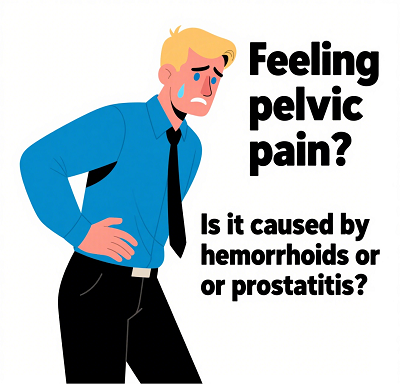Pelvic Pain: Is It Hemorrhoids or Prostatitis? Here's How to Tell the Difference
James, 32, an American engineer who has been tossed around a lot lately. For several weeks in a row, he had a constant pain deep in his pelvis. Sometimes this pain would burn near the anus like a hemorrhoid attack; other times, it would spread to the groin. He couldn't really tell if it was the pelvic pain from the hemorrhoids or the pain from the prostatitis that was causing him so much pain, so he finally went to see a urologist.

In fact, it's really not uncommon to find people like James who can't tell if it's hemorrhoid pain or prostatitis pain. Prostatitis and hemorrhoids are both common male ailments, and when the pain hits, many people are often confused, but it is actually possible to tell the difference as long as you understand their different causes.
The main differences between them are the following:
1. Different Causes
Prostatitis centers on the inflammation of the prostate gland itself. Bacterial invasion or pelvic floor neuromuscular dysfunction is a common trigger; sedentary pressure and a spicy diet will aggravate the condition.
The essence of hemorrhoids is the lesion of the anal veins, long-term constipation, or carrying heavy objects will give blood vessels "pressure, and finally, the blood vessels bulging (varicose veins) or mucous membrane down (prolapse), hemorrhoids.
2. Different Locations of the Pain
Prostatitis pain is deeper, focusing on the perineum (between the anus and scrotum), and may be accompanied by stomach cramps, lumbar and sacral pain.
The pain of hemorrhoids is in the anus, especially when defecating, and the sharp pain even makes people afraid to sit down.
3. Different Urinary Symptoms
Urinary abnormalities are the "identity card" of prostatitis: urinary frequency (always needing to urinate, especially at night), urinary urgency (unable to hold back), and incomplete urination are typical features. Some patients who get up in the morning may also notice a little sticky secretion on the urethra.
And the signs of hemorrhoids at the end of defecation: are when the stool drops bright red blood, the anus has meatballs fall out, the underwear is always dirty mucus, the pain is intense and they are even unable to defecate.
4. Different Sexual dysfunctions
People suffering from hemorrhoids usually do not experience sexual dysfunction.
On the other hand, people with prostatitis may experience sexual dysfunction problems such as impotence and premature ejaculation. This is because the prostate gland is closely related to the reproductive system, and when inflammation occurs, it will cause some interference with the patient's sexual nerves, which in turn affects normal sexual function, such as resulting in the inability to have an erection, ejaculation pain, or diminished pleasure.
5. Different Ages of Onset
Prostatitis is more often seen in 20-50-year-old young adults, and staying up late overtime, socializing and drinking, riding sedentary, and other modern lifestyles have a strong link.
Hemorrhoids are more common in people over 40 years of age, especially older people with constipation, pregnant women, and heavy laborers.
6. Different Treatments
Prostatitis:
If it is a bacterial infection, the doctor will prescribe anti-inflammatory drugs such as the common levofloxacin. For patients preferring natural remedies, the Diuretic and Anti-inflammatory Pill, a traditional Chinese herbal formula, offers a safe and effective alternative. It helps reduce inflammation, improve pelvic circulation, and relieve discomfort without the side effects commonly seen in antibiotics.
Warm sitz baths are a comfortable and effective way to relieve pain and muscle tension.
Of course, changing bad habits is fundamental: sit less and move more, avoid holding your urine, and adopt a lighter diet.
Hemorrhoids:
For patients with mild symptoms, use a hemorrhoid suppository, apply some ointment, and increase the consumption of vegetables, fruits, and coarse grains to ensure the stool is smooth and effortless. This is the key.
Patients with serious symptoms, especially hemorrhoids out of the plug, can not go back, or the formation of a large thrombus is painful may have to do a small surgery (such as PPH minimally invasive surgery), and the problem of hemorrhoids cut off.
In summary, in prostatitis and hemorrhoids, the pain difference mainly includes the cause of the disease, the location of the pain, urination symptoms, sexual dysfunction is not impaired, the age of onset and treatment methods, and other aspects of the difference, the patient can be based on these symptoms to distinguish.
Of course, the most reliable method is to let a doctor conduct a professional examination to confirm the diagnosis, identify the underlying cause of the disease, and provide accurate treatment, thereby achieving twice the result with half the effort.



